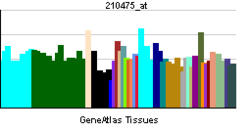POU3F1
| View/Edit Human | |||
POU domain, class 3, transcription factor 1 (also known as Oct-6) is a protein that in humans is encoded by the POU3F1 gene.[2][3]
See also
References
- ↑ "Human PubMed Reference:".
- ↑ Tobler A, Schreiber E, Fontana A (Feb 1993). "The human Oct-6 POU transcription factor lacks the first 50 amino acids of its murine counterpart". Nucleic Acids Research. 21 (4): 1043. doi:10.1093/nar/21.4.1043. PMC 309249
 . PMID 8451175.
. PMID 8451175. - ↑ "Entrez Gene: POU3F1 POU domain, class 3, transcription factor 1".
Further reading
- Monuki ES, Kuhn R, Weinmaster G, Trapp BD, Lemke G (Sep 1990). "Expression and activity of the POU transcription factor SCIP". Science. 249 (4974): 1300–3. doi:10.1126/science.1975954. PMID 1975954.
- Suzuki N, Rohdewohld H, Neuman T, Gruss P, Schöler HR (Nov 1990). "Oct-6: a POU transcription factor expressed in embryonal stem cells and in the developing brain". The EMBO Journal. 9 (11): 3723–32. PMC 552128
 . PMID 1976514.
. PMID 1976514. - Zwilling S, König H, Wirth T (Mar 1995). "High mobility group protein 2 functionally interacts with the POU domains of octamer transcription factors". The EMBO Journal. 14 (6): 1198–208. PMC 398197
 . PMID 7720710.
. PMID 7720710. - Leger H, Sock E, Renner K, Grummt F, Wegner M (Jul 1995). "Functional interaction between the POU domain protein Tst-1/Oct-6 and the high-mobility-group protein HMG-I/Y". Molecular and Cellular Biology. 15 (7): 3738–47. doi:10.1128/mcb.15.7.3738. PMC 230612
 . PMID 7791781.
. PMID 7791781. - Faus I, Hsu HJ, Fuchs E (May 1994). "Oct-6: a regulator of keratinocyte gene expression in stratified squamous epithelia". Molecular and Cellular Biology. 14 (5): 3263–75. doi:10.1128/mcb.14.5.3263. PMC 358693
 . PMID 7909356.
. PMID 7909356. - Abdel-Rahman B, Fiddler M, Rappolee D, Pergament E (Oct 1995). "Expression of transcription regulating genes in human preimplantation embryos". Human Reproduction. 10 (10): 2787–92. PMID 8567814.
- Jaegle M, Mandemakers W, Broos L, Zwart R, Karis A, Visser P, Grosveld F, Meijer D (Jul 1996). "The POU factor Oct-6 and Schwann cell differentiation". Science. 273 (5274): 507–10. doi:10.1126/science.273.5274.507. PMID 8662541.
- Sock E, Enderich J, Rosenfeld MG, Wegner M (Jul 1996). "Identification of the nuclear localization signal of the POU domain protein Tst-1/Oct6". The Journal of Biological Chemistry. 271 (29): 17512–8. doi:10.1074/jbc.271.29.17512. PMID 8663425.
- Malik KF, Jaffe H, Brady J, Young WS (Apr 1997). "The class III POU factor Brn-4 interacts with other class III POU factors and the heterogeneous nuclear ribonucleoprotein U". Brain Research. Molecular Brain Research. 45 (1): 99–107. doi:10.1016/S0169-328X(96)00238-0. PMID 9105675.
- Sumiyama K, Washio-Watanabe K, Ono T, Yoshida MC, Hayakawa T, Ueda S (Feb 1998). "Human class III POU genes, POU3F1 and POU3F3, map to chromosomes 1p34.1 and 3p14.2". Mammalian Genome. 9 (2): 180–1. doi:10.1007/s003359900721. PMID 9457692.
- Arroyo EJ, Bermingham JR, Rosenfeld MG, Scherer SS (Oct 1998). "Promyelinating Schwann cells express Tst-1/SCIP/Oct-6". The Journal of Neuroscience. 18 (19): 7891–902. PMID 9742157.
- Kawasaki T, Oka N, Tachibana H, Akiguchi I, Shibasaki H (Mar 2003). "Oct6, a transcription factor controlling myelination, is a marker for active nerve regeneration in peripheral neuropathies". Acta Neuropathologica. 105 (3): 203–8. doi:10.1007/s00401-002-0630-9. PMID 12557005.
- Beck IM, Müller M, Mentlein R, Sadowski T, Mueller MS, Paus R, Sedlacek R (May 2007). "Matrix metalloproteinase-19 expression in keratinocytes is repressed by transcription factors Tst-1 and Skn-1a: implications for keratinocyte differentiation". The Journal of Investigative Dermatology. 127 (5): 1107–14. doi:10.1038/sj.jid.5700674. PMID 17195013.
- Ryu EJ, Wang JY, Le N, Baloh RH, Gustin JA, Schmidt RE, Milbrandt J (Oct 2007). "Misexpression of Pou3f1 results in peripheral nerve hypomyelination and axonal loss". The Journal of Neuroscience. 27 (43): 11552–9. doi:10.1523/JNEUROSCI.5497-06.2007. PMID 17959798.
External links
- POU3F1 protein, human at the US National Library of Medicine Medical Subject Headings (MeSH)
This article incorporates text from the United States National Library of Medicine, which is in the public domain.
This article is issued from Wikipedia - version of the 11/24/2016. The text is available under the Creative Commons Attribution/Share Alike but additional terms may apply for the media files.

